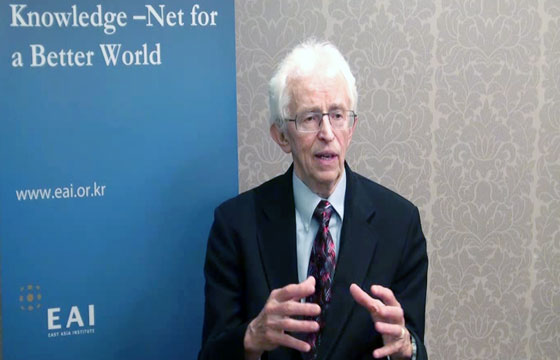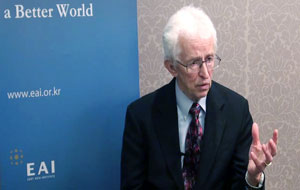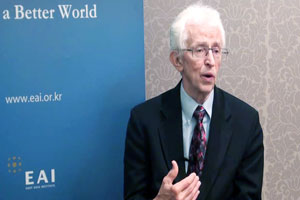![[Smart Q&A: Siegfried S. Hecker] North Korea’s Nuclear Capabilities and Recommendations for Future Six-Party Talks](../images/bg_tmp.jpg)
[Smart Q&A: Siegfried S. Hecker] North Korea’s Nuclear Capabilities and Recommendations for Future Six-Party Talks
Global NK Zoom & Connect | Multimedia | 2013-09-30

Siegfried S. Hecker is a professor (research) in the Department of Management Science and Engineering and a senior fellow at CISAC and FSI. He is also an emeritus director of Los Alamos National Laboratory. He was co-director of CISAC from 2007-2012. Hecker currently is on sabbatical working on a book project and will return to Stanford in the summer of 2013 to resume his research and teaching. Hecker’s research interests include plutonium science, nuclear weapons policy and international security, nuclear security (including nonproliferation and counter terrorism), and cooperative nuclear threat reduction. Over the past 18 years, he has fostered cooperation with the Russian nuclear laboratories to secure and safeguard the vast stockpile of ex-Soviet fissile materials. His current interests include the challenges of nuclear India, Pakistan, North Korea, and the nuclear aspirations of Iran. Hecker works closely with the Russian Academy of Sciences and is actively involved with the U.S. National Academies.
China suggested a gathering of senior officials and academics from the U.S., China, the two Koreas, Japan and Russia on September 18 to commemorate the 10th anniversary of the Six-Party Talks. However, Ben Rhodes, the deputy national security adviser for strategic communication to U.S. President Barack Obama, reiterated Washington’s position that the U.S. has no intention to resume the talks unless Pyongyang demonstrates its seriousness about denuclearization and the negotiation process. U.S. Special Representative for North Korea Policy Glyn Davies confirmed Washington’s position during his visits to South Korea, China and Japan from September 8 to 13.
On September 13, The East Asia Institute invited Siegfried S. Hecker, professor in the Department of Management Science and Engineering and a senior fellow at Center for International Security and Cooperation at Stanford University and Freeman Spogli Institute for International Studies, to assess the recent developments in North Korea’s nuclear capabilities, identify possible criteria that Pyongyang should meet for the resumption of the Six-Party Talks, and suggest policy recommendations for the future talks.
Q1: According to the interview you had with the Korea Institute for National Unification (KINU) in April 2013 and the paper you presented at the conference on “Rethinking Nuclear Issues in Northeast Asia” in 2012, Pyongyang has pursued both nuclear energy and nuclear weapons capabilities by taking the paths of both a plutonium program and uranium-enrichment program simultaneously. What is the difference between the plutonium program and uranium-enrichment program? Which one poses more of a threat to the Northeast Asian region?
A1: “…not because of the destructive power it can yield but because of the detection problem, the HEU program poses more of a threat.”
As both programs can produce nuclear bombs, they are equally dangerous. The nuclear bomb that destroyed Hiroshima was a uranium bomb, while the one which turned Nagasaki to ashes was a plutonium bomb.
As the three nuclear tests that Pyongyang conducted in 2006, 2009, and 2013 show, it is quite certain that North Korea possesses nuclear weapons, but not much of an arsenal. In order to build a nuclear bomb, you need fuel: either plutonium, or highly-enriched uranium. North Korea produced plutonium from its 5 Megawatt-electric (MWe) gas-graphite reactor at Yongbyon before the 1994 Agreed Framework halted it. This facility restarted in 2003 and shut down again in July 2007 as a result of the Six-Party Talks. It is quite certain that North Korea hasn’t produced more plutonium in the reactor since 2007. But the satellite images have shown indications that Pyongyang restarted the facility at Yongbyon very recently. Based on my calculations, North Korea likely has enough plutonium to make 4 to 8 nuclear bombs. Pyongyang appears to have used plutonium bombs for the first and second nuclear tests.
The second way to make a nuclear bomb is to use enriched uranium. During my most recent visit to North Korea in 2010, North Korea showed my Stanford colleagues John Lewis, Robert Carlin and me a modern uranium centrifuge-enrichment plant; this was big news because many specialists, including myself, did not believe that North Korea possessed such a capability. While North Korea has only a limited stockpile of plutonium, its centrifuge facility could produce highly-enriched uranium (HEU) continuously. It is uncertain how much HEU North Korea has produced in this facility. I think it is likely that the facility the North Koreans showed me in 2010 in Pyongyang was designed to produce LEU for their Light-Water-Reactor (LWR). But we do not know if it is still producing LEU or if it has been reconfigured for HEU, or what another North Korean facility might be producing.
This makes the uranium-enrichment program more dangerous. The centrifuge facilities are quite small and it is hard to to know where they are in North Korea or how large they are. Thus, not because of the destructive power it can yield but because of the detection problem, the HEU program poses more of a threat. As mentioned above, the reactors that make plutonium facilities are easy to find through the overhead satellite images. It is also true that an HEU bomb is easier to make compared to a plutonium bomb. The first nuclear bomb that the United States made was a uranium bomb. But North Korea has already demonstrated it has the capability to build a plutonium bomb - the more complicated bomb to produce. The fact that a uranium bomb is easier to complete is not really crucial with respect to evaluating the dangerousness of the program.
One important thing to remember is that compared to a uranium bomb, a plutonium bomb is easier to miniaturize and has more benefits in terms of making nuclear warheads that can be put on top of missiles. That may be why Pyongyang recently restarted the facility that can produce plutonium again. North Korea will likely continue to pursue both plutonium and uranium programs in this regard.
Q2: How much development, do you believe, has North Korea achieved in terms of miniaturizing nuclear warheads to fit on its missiles? How many tests will be needed for North Korea to have confidence in this nuclear weapons capability?
A2: “…it is obvious that the three nuclear tests which Pyongyang has conducted – the first one: not really successful, the second one: fairly successfully, and the third one: quite successful – have likely not allowed North Korea to have confidence in its capability of miniaturizing nuclear warheads suitable for missiles.”
 The nuclear bombs that were dropped on Hiroshima and Nagasaki were primitive bombs. They were both quite large bombs, especially the uranium bomb. Although it is possible to make a uranium bomb smaller, to the extent that it could be put onto missiles, it requires many tests. That was exactly what the U.S. and Soviet Union did. Of course, North Korea can take advantage as a follower and possibly exploit other countries’ experience. However, it is obvious that the three nuclear tests which Pyongyang has conducted – the first one: not really successful, the second one: fairly successfully, and the third one: quite successful – have likely not allowed North Korea to have confidence in its capability of miniaturizing nuclear warheads suitable for missiles. Especially in order to be loaded onto intercontinental ballistic missiles (ICBMs) like the Musudan or Taepodong, the size of the warhead needs to be smaller and lighter. In order to do so, Pyongyang definitely needs more tests.
The nuclear bombs that were dropped on Hiroshima and Nagasaki were primitive bombs. They were both quite large bombs, especially the uranium bomb. Although it is possible to make a uranium bomb smaller, to the extent that it could be put onto missiles, it requires many tests. That was exactly what the U.S. and Soviet Union did. Of course, North Korea can take advantage as a follower and possibly exploit other countries’ experience. However, it is obvious that the three nuclear tests which Pyongyang has conducted – the first one: not really successful, the second one: fairly successfully, and the third one: quite successful – have likely not allowed North Korea to have confidence in its capability of miniaturizing nuclear warheads suitable for missiles. Especially in order to be loaded onto intercontinental ballistic missiles (ICBMs) like the Musudan or Taepodong, the size of the warhead needs to be smaller and lighter. In order to do so, Pyongyang definitely needs more tests.
It is uncertain, however, when North Korea will be fully confident regarding the effectiveness of their nuclear weapons capability. History tells us that the United States, Soviet Union, India, and Iran had to spend quite a bit of time developing their capabilities, while China conducted four nuclear tests and became fully confident of its capability relatively quickly. The problem of how many tests would be needed in order for Pyongyang to become confident in its nuclear weapons depends on how much Pyongyang has learned from its predecessors.
Q3: What is the most serious threat that North Korea currently poses among the so-called nuclear 3S (security, safety, and safeguards) according to the U.S. perspective?
A3: “…basically I worry about all the elements of the North Korean nuclear threat, but the most dangerous threat is the possibility of a nuclear attack from Pyongyang.”
The most serious threat posed by the North Korean nuclear program is the possibility of witnessing mushroom clouds on the Korean Peninsula. Although it is highly unlikely that Pyongyang would launch a nuclear attack, as long as there is potential for miscalculation from a young and untested leader, this is a serious challenge. Regarding the safeguarding of nuclear weapons and missiles and the security of fissile materials issue, since North Korea is one of the most authoritarian regimes in the world, we would have fewer problems. However, the transfer of nuclear technology from Pyongyang to other countries, which already happened in the Syrian case, is quite feasible and dangerous. I do not think it is likely that the North Koreans would transfer actual material to another state; however, there is the possibility that it could transfer its experience or technology. Furthermore, the nuclear-safety issue draws strong concern from the public and even hinders the development of nuclear energy programs in countries like United States and South Korea. But authoritarian regimes like North Korea do not care much about the safety issue. Because of this, North Korea’s nuclear facilities, especially the new LWR, could pose an environmental threat to the region due to safety issues. In summary, basically I worry about all the elements of the North Korean nuclear threat, but the most dangerous threat is the possibility of a nuclear attack from Pyongyang.
Q4: Based on your observations, what should Pyongyang do to persuade the U.S. that it is ready for “authentic and credible” talks? Please identify the measures that North Korea should take in order to assure the U.S., South Korea, and Japan on its seriousness about dialogue.
A4: “Clearly, any seriousness cannot be corroborated by words. It requires concrete steps.”
Clearly, any seriousness cannot be corroborated by words. It requires concrete steps. From the technical perspective, North Korean nuclear capabilities are becoming more dangerous. We need to take measures to prevent the situation from getting worse and should rollback Pyongyang’s nuclear development as soon as possible.
North Korea can take several technical steps to signal to the international community that it has a serious intention to commit to denuclearization. First, Pyongyang did freeze the small reactor at Yongbyon several times – but never destroyed it. They should destroy the reactor! They could do this quite easily by poisoning the core so it could never be used again. Even though it will not stop North Korean nuclear development, the measure will delay the enhancement of the program greatly. Second, North Korea still retains considerable amounts of natural uranium fuel rods which were produced before the 1994 Agreed Framework. Sell them! Third, dismantle the front end of the plutonium reprocessing facility, so that it would no longer be able to accept spent fuel. Fourth, destroy the test tower and tunnel at the nuclear test site. These actions are not only symbolic, but they are also concrete ways to show Pyongyang’s commitment to denuclearization.
 Q5: How do you evaluate the effectiveness of the Six-Party Talks? Will the resumption of the Talks help to solve the North Korean nuclear crisis? What would you recommend for future negotiations?
Q5: How do you evaluate the effectiveness of the Six-Party Talks? Will the resumption of the Talks help to solve the North Korean nuclear crisis? What would you recommend for future negotiations?
A5: “The Six-Party Talks are the only game in town.”
The Six-Party Talks are the only game in town. As the party directly concerned, South Korea would never be excluded from the negotiation process. Because of its diplomatic leverage, China needs to be included, and U.S. participation is essential as well. It would be difficult to continue now without Japan and Russia after this long in the process. It is true that the Six-Party Talks have not been very successful so far. Now is the time to consider the concrete steps mentioned above to help rollback the North Korean program and stop the situation from getting worse. ■
Prepared by the Peace and Security Research Unit at the East Asia Institute. The East Asia Institute acknowledges the grant support from the MacArthur Foundation that made this event possible. The East Asia Institute takes no institutional position on policy issues and has no affiliation with the Korean government. This report was prepared by Yang Gyu Kim, research fellow at EAI.
Center for North Korea Studies
Global NK Zoom & Connect